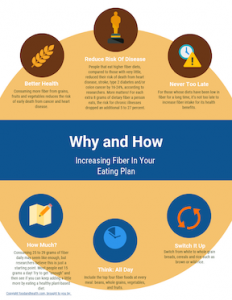More fiber means less disease
While fad diets that demonize carbs are always popular at the start of the New Year, science and common sense still lean towards including them in your diet. A recent large analysis finds that consuming grains, fruits and vegetables reduces the risk of early death from cancer and heart disease. 1People that eat higher fiber diets, compared to those with very little, reduced their risk of death from heart disease, stroke, type 2 diabetes and/or colon cancer by 16-24%, according to researchers. More matters! For each extra 8 grams of dietary fiber a person eats, the risk for chronic illnesses dropped an additional 5 to 27 percent. 1Study author Andrew Reynolds, a postdoctoral research fellow at the University of Otago in New Zealand notes, "The health benefits of fiber are supported by over 100 years of research into its chemistry, physical properties, physiology and effects on metabolism”. Reynolds notes he was surprised at the number of chronic illnesses that higher intakes of dietary fiber improved including heart disease, type 2 diabetes and colon cancer, to name a few. 1 The findings come as a result of 185 observational studies done over the past forty years, along with 58 clinical trials with over 4,600 participants. Reynolds and his researchers were commissioned by the WHO and reported in Lancet online in January of this year. His team stated that globally, people eat less than 20 grams of fiber daily and Americans consume even less, at about 15 grams per day. Fiber intake can easily be improved through a variety of foods such as whole wheat bread, steamed broccoli, a fresh orange, or a cup of black beans. 1
Consuming 25 to 29 grams of fiber daily may seem like enough, but Reynolds and his researchers believe this is just a starting point. Best protection from premature death was seen in individuals who regularly consumed even larger amounts of fiber. For every extra 15- gram increase in whole grain intake, a person’s overall risk of early death as well as death from heart disease declined between 2 and 19 percent. 1
In addition, the scientists discovered that increasing fiber intake was not detrimental to your health. For those whose diets have been low in fiber for a long time, it’s not too late to increase fiber intake for its health benefits. According to Reynolds, "We saw this from the trials where participants were asked to increase their fiber intakes," he said. "When considering all the trials of increasing fiber intakes, those participants that did reduced both their body weight and the total cholesterol in their blood, two important predictors of disease." 1Dr. Gerald Bernstein, program director for the Friedman Diabetes Institute at Lenox Hill Hospital in NY City agrees with Dr. Reynolds. "I do not think there is a time to start that is not beneficial," he said. "Of course, combined with some exercise and calorie control the benefits become exponential." 1Bernstein notes that the findings aren’t surprising, but should “lead to a change in dietary recommendations”. Lona Sandon, a program director and associate professor in the department of clinical nutrition for the school of health professions at the University of Texas Southwester Medical Center in Dallas agrees. "This is just one more that supports and further solidifies the recommendations registered dietitian nutritionists have been making for years," said Sandon. 1Sandon states "It's never too late to start on a healthy diet,". "Sure, you may have missed out on some health prevention years and therefore your risk will not be as low as someone who has been eating whole grains all their life. But you have nothing to lose by giving a healthy diet a try." 1Dietitians can encourage their clients to get more fiber in their diets with simple tips:
- Start the day with whole grains like steel cut oats, shredded wheat cereal or 100% whole grain toast.
- Switch from white to whole grain breads, cereals and rice such as brown or wild rice.
- Include a ½ cup serving of beans, peas or lentils three or more times per week. Beans can easily be added to salads, soups or side dishes.
- Add vegetables at all meals, including breakfast. Spinach, broccoli, peppers or mushrooms are great in eggs or can be roasted.
- Include whole fruit as a snack or part of a meal. Berries are one of the highest fiber fruits and offer vitamin C and other antioxidants.
- Toss quinoa, bulgur, farro and other high fiber grains in your salads or use as a side dish. These grains are often two to three times higher in fiber than rice or potatoes.
[shopify embed_type="product" shop="nutrition-education-store.myshopify.com" product_handle="microbiome-powerpoint-and-handouts-download"]Reference:Andrew Reynolds, Ph.D., postdoctoral research fellow, department of medicine, University of Otago, Dunedin, New Zealand; Gerald Bernstein, M.D., program coordinator, Friedman Diabetes Institute, Lenox Hill Hospital, New York City; Lona Sandon, Ph.D., R.D.N., L.D., program director and associate professor, department of clinical nutrition, School of Health Professions, University of Texas Southwestern Medical Center at Dallas; Jan. 10, 2019, The Lancet, onlineSubmitted by Lisa Andrews, MEd, RD, LDDownload a Fiber PDF Printable Handout Flyer now: [shopify embed_type="collection" shop="nutrition-education-store.myshopify.com" product_handle="whole-grain-health-fair-display"][shopify embed_type="collection" shop="nutrition-education-store.myshopify.com" product_handle="fiber-and-microbiome"]
[shopify embed_type="collection" shop="nutrition-education-store.myshopify.com" product_handle="whole-grain-health-fair-display"][shopify embed_type="collection" shop="nutrition-education-store.myshopify.com" product_handle="fiber-and-microbiome"]


